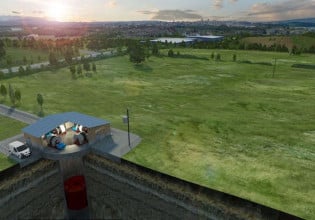Fusion Future Calls: Unlocking It With Public-Private Partnerships
Industry, government, and universities must work together to make fusion energy more viable.
Imagine a world where unlimited electricity is produced by a nonpolluting, carbon-free process that consumes little more than seawater and produces no waste. If it sounds too good to be true, consider the proponents of nuclear fusion.
EUROfusion. Image used courtesy of Wikimedia Commons
Nuclear fusion can deliver energy without carbon emissions or radioactive waste. But to achieve grid-scale fusion, private, public, and academic institutions must combine their efforts, according to a recent report.
Nuclear Fusion: Like the Sun
Nuclear fusion powers the sun and all other stars in the universe. During fusion, two light atomic nuclei combine to form a single heavier nucleus. This not only produces a new element but also releases a large amount of energy. In a star, the two small nuclei are hydrogen, and the resulting heavier element that is formed is helium.
Back on Earth, engineers have learned how to use nuclear reactions to produce weapons and atomic power. However, nuclear energy uses a fission reaction using uranium, plutonium, and other highly radioactive materials. As a result, the waste products are also highly radioactive and must be safely stored for 10,000 years or more before their radioactivity levels have dropped enough to be safe for humans.
Fusion Reactions Aren’t Easy
Unlike fission reactions, fusion reactions do not produce radioactive waste. But even after more than seven decades of research, it was only last year that researchers at Lawrence Livermore National Laboratory reached scientific energy breakeven with their nuclear fusion experiments. Energy breakeven means the fusion reaction produces more energy than the energy input to drive it.
Nuclear fusion needs extremely high temperatures and pressures. The hydrogen plasma must be about six times hotter than the sun’s core temperature. This high-temperature hydrogen plasma must be confined using magnetic containment long enough for fusion to occur.
Comparison of nuclear fission and fusion. Image used courtesy of Department of Energy
In the Lawrence Livermore experiment, scientists created a plasma consisting of hydrogen isotopes of deuterium and tritium at temperatures reaching 100 million degrees Kelvin. When the nuclei of these two hydrogen isotopes combine, they form a single nucleus of helium. The resulting helium nucleus has a slightly lower mass than the two original hydrogen nuclei. According to Einstein's famous equation E=mc2, the missing mass converts to energy.
If the energy created from a nuclear fusion reaction could be captured, it could be used to create steam to power a turbine and generator capable of producing electricity for the power grid, all without the greenhouse gas emissions produced by coal, oil, or natural gas or the radioactive waste from uranium fission reactors.
How To Achieve Nuclear Fusion Energy
At present, private industry conducts most fusion research, largely financed by government grants. The Biden administration aims to create a commercial nuclear fusion facility within 10 years, and last year, the Department of Energy provided $46 million to eight fusion companies to develop designs for nuclear fusion pilot plants. To accelerate fusion development, the administration has proposed major increases in the Fusion Energy Sciences program within the Office of Science.
DIII-D National Fusion Facility. Image used courtesy of Department of Energy
In the journal Physics of Plasmas, experts outlined a framework for public-private partnerships stressing the importance of academia to the industry’s development. Authors from academia, government, and private industry, contributed to the study. They noted the size and scale of fusion research in U.S. academic institutions is insufficient to support the growth required for fusion to reach a viable form of energy production.
Fusion Energy Goes Back to College
Historically, academic institutions have worked closely with industry in fields like biotechnology, computing, materials science, and aeronautics, and the number of tenured faculty at the nation's universities represents that partnership. At present, 57 universities in the United States are active in plasma and fusion research. However, on average, only two tenured or tenure-track plasma/fusion faculty work at these institutions.
Developing fusion energy requires the contributions of physicists, materials engineers, chemists, and computer scientists—specialties found at a large university. Students who study in such a collaborative environment will be better prepared to join a workforce capable of building a nuclear fusion industry. Managing the growth of nuclear fusion energy will also require specific expertise in areas like safety, finance, and grid integration. Developing more extensive partnerships between government, private industry, and academic institutions enhances the potential for viable nuclear fusion energy.









